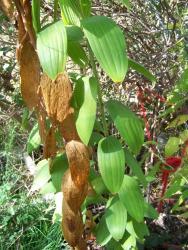One again I am asking our Lilium experts for advise.
The foliage of the Oriental Lilium(?) in the picture corresponds to a pot with 3 bulbs of white flowered lilies (maybe Casablanca).
All were planted at the same time in specially purchased acidic soil, bloomed simultaneously as well and are located in dappled shade.
As you can see, one stem is wilted while the other 2 are still green. I also observed that the brown one aquired that colour almost over night, but the leaves' tissue remained soft for several days (not papery as regular).
Please let me know if this is a disease and, being this the case, if the other bulbs are in danger and what I should do.
Thank you very much beforehand.

